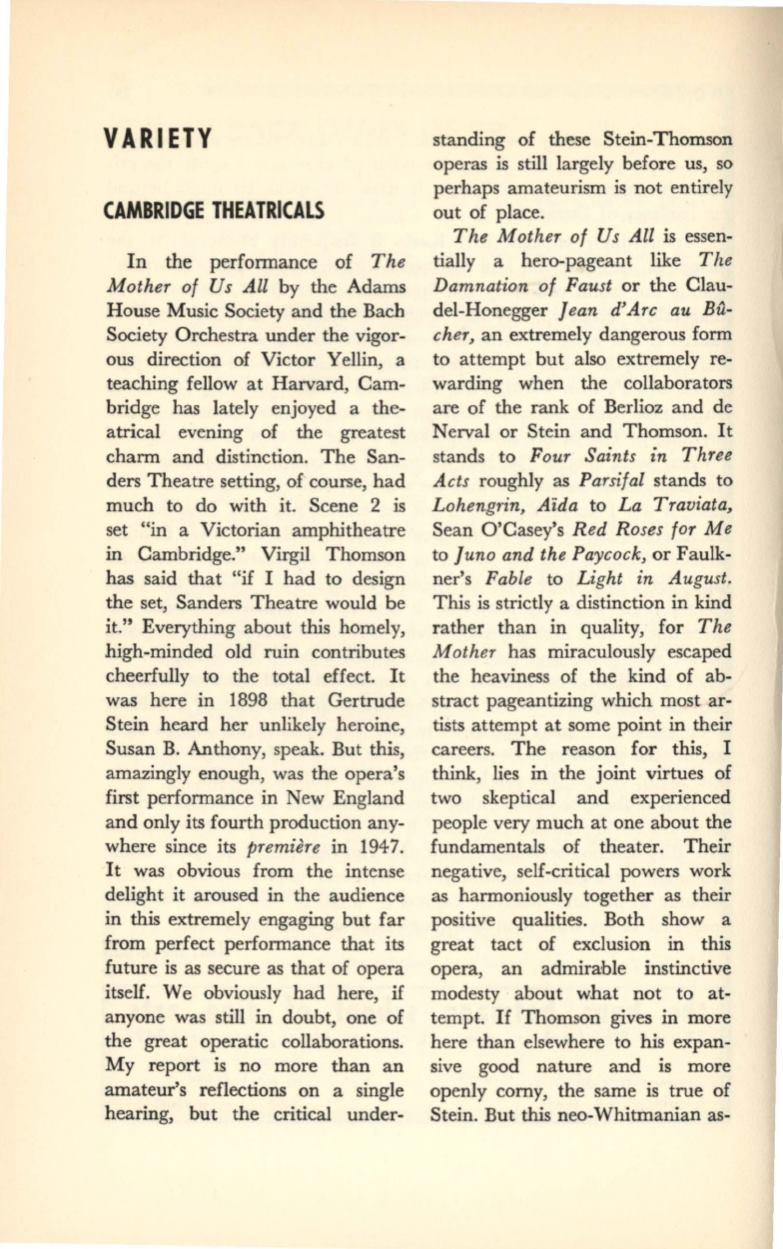
VARIETY
CAMBRIDGE THEATRICALS
In the performance of
The
Mother of Us All
by the Adams
House Music Society and the Bach
Society Orchestra under the vigor–
ous direction of Victor Yellin,
a
teaching fellow at Harvard, Cam–
bridge has lately enjoyed a the–
atrical evening of the greatest
charm and distinction. The San–
ders Theatre setting, of course, had
much to do with it. Scene 2 is
set "in a Victorian amphitheatre
in Cambridge." Virgil Thomson
has said that "if I had to design
the set, Sanders Theatre would be
it." Everything about this homely,
high-minded old ruin contributes
cheerfully to the total effect. It
was here in 1898 that Gertrude
Stein heard her unlikely heroine,
Susan B. Anthony, speak. But this,
amazingly enough, was the opera's
first performance in New England
and only its fourth production any–
where since its
premiere
in 1947.
It was obvious from the intense
delight it aroused in the audience
in this extremely engaging but far
from perfect performance that its
future is as secure as that of opera
itself. We obviously had here,
if
anyone was still in doubt, one of
the great operatic collaborations.
My report is no more than an
amateur's reflections on a single
hearing, but the critical under-
standing of these Stein-Thomson
operas is still largely before us, so
perhaps amateurism is not entirely
out of place.
The Mother of Us All
is essen–
tially a hero-pageant like
The
Damnation of Faust
or the Clau–
del-Honegger
Jean d'Arc au
Bu–
cher,
an extremely dangerous form
to attempt but also extremely re–
warding when the collaborators
are of the rank of Berlioz and de
Nerval or Stein and Thomson.
It
stands to
Four Saints in Three
Acts
roughly as
Parsifal
stands to
Lohengrin, Aida
to
La Traviata,
Sean O'Casey's
Red Roses for Me
to
Juno and the Paycock,
or Faulk–
ner's
Fable
to
Light in August.
This is strictly a distinction in kind
rather than in quality, for
The
Mot her
has miraculously escaped
the heaviness of the kind of ab–
stract pageantizing which most ar–
tists attempt at some point in their
careers. The reason for this, I
think, lies in the joint virtues of
two skeptical and experienced
people very much at one about the
fundamentals of theater. Their
negative, self-critical powers work
as harmoniously together as their
positive qualities. Both show a
great tact of exclusion in this
opera, an admirable instinctive
modesty about what not to at–
tempt.
If
Thomson gives in more
here than elsewhere to his expan–
sive good nature and is more
openly corny, the same is true of
Stein. But this neo-Whitmanian as-


